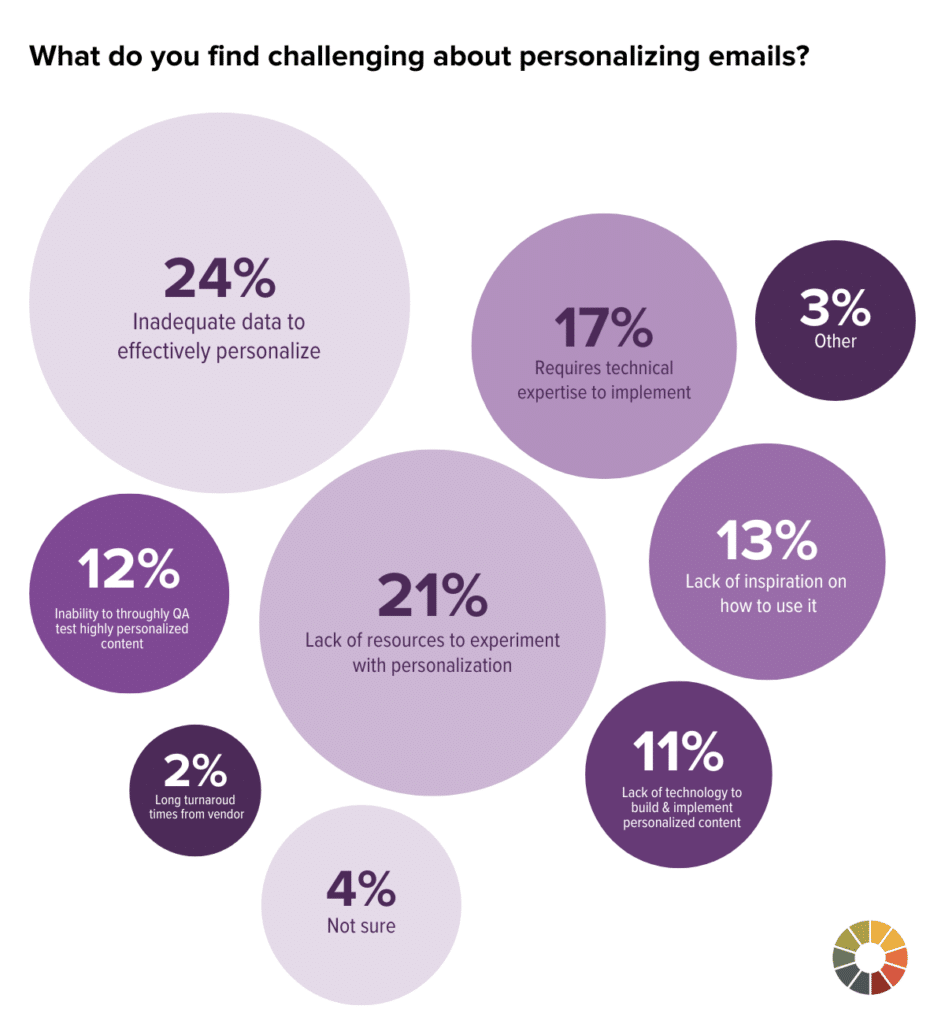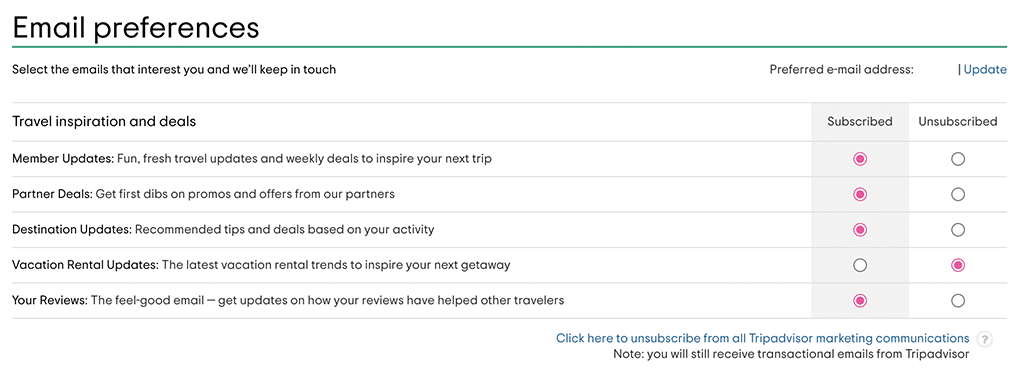Email personalization is consistently one of the biggest priorities for marketers—but it’s also one of the things that’s making them tear their hair out.
There’s good reason for both of these facts. Personalized email helps captivate audiences with true 1:1 experiences, leads to more engaged subscribers throughout the customer journey, and increases conversions, conversion rates, and, ultimately, revenue growth.
When we asked marketers about personalized email content for our State of Email Innovations Report, we found out that 95% do some sort of email personalization, even if it’s sticking to basics like “first name” merge tags.
But only 3% of marketers use live or real-time dynamic content, which is the key to unlocking the true benefits of email personalization.
When we asked you what was stopping you from going all-in on email personalization strategies, lack of data (24%), lack of resources (21%), and lack of inspiration (13%) topped the list.

The good news is that all of those complaints are totally fixable.
Buckle up, email geeks. We’ve put together a comprehensive guide to all the email personalization best practices you need to know, plus a handy-dandy downloadable to use for your team.
5 email personalization best practices for a winning strategy
Email personalization takes effort, but it pays off big time for your email marketing strategy. 76% of buyers expect personalized experiences because they understand that they reflect a brand’s commitment to understanding their needs and preferences.
Giving emails a personal touch isn’t just a nice way to do email marketing or make emails look pretty. They actually drive results.
When you deliver emails that speak directly to your subscribers where they are in their customer journey, they feel more connected to your brand. Says Litmus Email Marketing Manager Tracie Pang, “When personalization is done right, it’s something subscribers are more likely to engage with. They’re more likely to click on a product, browse your website, and make a purchase.”
What are the best practices for personalizing email campaigns to increase engagement?
Here are five email personalization best practices that make it happen:
1. Collect (and organize) as much data as you can
24% of email marketers told us they struggle to find the right data to personalize their email marketing campaigns. Oof, we feel you. Google’s ending third-party cookies and Apple Mail Privacy Protection have been a one-two punch for email marketers looking to find ways to target their subscribers more effectively.
But guess what? You have access to a lot more data than you think. Instead of lamenting the end of third-party data, it’s time to use the data you have:
- Zero-party data is explicitly given to you by your audience, either through surveys or polls or purchase data. Anytime you’re asking your subscribers a question and they answer it, it’s zero-party data.
- First-party data is the individual-level data collected from your audience, like browsing data from your website, shopping history, or social media engagement.
- Second-party data is purchased from another company—basically, someone else’s first-party data. Second-party data gives you context and scale, helping you understand consumer trends, analyze the competitive landscape, or conduct research.
Email marketers using zero-party data in particular are at a huge advantage in the personalization game. Whether it’s their topic preferences, wishlisted products, or survey results, you can use email to generate data for future personalized campaigns.
2. Know your audience better than they know themselves
Once you have the right data, you can start brainstorming different ways to personalize your email campaigns. You don’t have to radically change your email marketing strategy to do this. Instead, think about the emails you’re already sending and how you can add variants to them based on the information you know about past purchases, browsing behavior, or customer support interactions.
Create super segments of each of your audience. You may already be splitting customers vs. prospects, for example. Now, take that one step further:
| Customers vs. Prospects | Personalized Campaign Idea | Data You Need |
|---|---|---|
| Customers who purchase products in multiple categories | Gift guide or come visit our store | Purchase behavior Stated preferences Geolocation |
| Customers who have purchased one product but not a second | Product recommendations | Purchase behavior Browsing history Stated preferences |
| Customers who have purchased 3+ products (aka your superfans) | Ask for a review or shout-out on social media | Purchase behavior Sentiment |
| Prospects who have been on site browsing in the last 24 hours | Back-in-stock or “get it before it’s gone” | Browsing history |
| Prospects who haven’t engaged with an email in 30 days or more | Re-engagement campaign | Email engagement Browsing history |
| Prospects who are thiiiiis close to making a purchase | Abandoned cart or abandoned browsing | Interest signals Browsing history |
Email personalization isn’t just about personalizing email subject lines, using “first name” or including specific information in your email, though these can be powerful personalization techniques.
Instead, it’s about providing the right nudge at the right time in the customer journey to get them thinking about your brand. That way, when they are ready to purchase for the first or the fifth time, it’s your brand they’ll go to first.
3. Go beyond first name tags with live or real-time content in your email designs
When it comes to actually building a personalized email, including live or real-time content can help your brand stand out. We were surprised to learn that only 3% of email marketers we surveyed had used live or real-time content in their personalization efforts, since the tactic showed up again and again when we asked you what you wish you could do with personalization.
Live or real-time content can be intimidating because unlike first-name merge tags, it can’t necessarily be handled by your ESP. Add features to your emails that make your subscribers excited to read them, like:
- Interest signals, which display live click totals so you can show subscribers what their peers are most excited about
- Countdown timers, which add a sense of urgency to your promotional emails
- Live polls, so subscribers see in-the-moment how their opinion matches with other subscribers
- Scratch-offs, which add a little interactive fun to emails by revealing a product or promotion on a click
Email marketing is always a race to see what’s new, delightful, and different. These kind of personalization tactics can give your emails a little extra something that gets subscribers engaging with your emails more.
4.Personalize email timing and frequency
Personalization isn’t just the content and design of your emails. You can optimize your larger email marketing strategy on a personalized level, too. That means sending your emails when a subscriber is most likely to read it — whether they’re checking emails during their morning commute or while relaxing after dinner.
You can do this using your open data through your ESP, but if that’s difficult to get at, then you’ve got nothing to lose by asking your subscribers directly. Beef up your subscriber preferences page with options to customize newsletter type, frequency, and timing.

5.Continuously test your emails (and include a fallback)
Part of what makes email personalization so tricky to pull off is that you’ve got a lot of moving parts that need to flow seamlessly together. You never want someone to receive a literal “FIRST NAME” in their email, or six emails instead of the one they were supposed to receive.
Any time you add personalization into an email campaign, make sure you include a generic fallback. You can swap out product recommendations for a bestseller campaign, for example, or include information on multiple product categories in an email instead of the one you know the subscriber is most interested in.
Start getting results from these email personalization best practices
Email personalization can help do all the typical things email marketers look for: increased click-through rates, collecting better customer data, and the creation of more relevant content in subscribers’ crowded inbox. But it’s more than simply improving email marketing metrics. Personalized messages help you develop and nurture a true customer relationship.
Personalized email campaigns offer the type of customer engagement that no typical mass email strategy can offer. Implementing the email personalization best practices will pay huge dividends and establish your brand as someone who truly understands its audiences and customers
To achieve it, you need an email marketing platform that’s built with personalization in mind.
If email personalization is a big priority for you this year, we’re here to help. Litmus Personalize is an easy way to create uniquely personalized, engaging email experiences that boost customer loyalty and drive higher conversions and revenue. Brands and teams of all types, from ecommerce to financial industries, have leveraged Litmus Personalize to take their personalized email strategy to the next level. Learn more about email personalization with Litmus Personalize.
The post Email Personalization Best Practices: The Ultimate Checklist for Email Marketers appeared first on Litmus.
https://www.litmus.com/blog/email-personalization-best-practices-the-ultimate-checklist-for-email-marketers